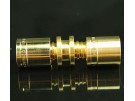Tech News
Let me start out by going on record as saying I don’t think manual is ever better than CNC except in certain special circumstances that are really not a test of manual vs CNC, but of other factors. I’ll walk through the three special circumstances in a moment.
I’ll be the first to admit it is a controversial viewpoint. Machinists will spend hours debating the whole manual versus CNC thing and every related issue. For example, they will debate whether you can be a decent CNC machinist without having trained extensively on manual machines first. I’m not going to try to answer that one here, but rather, I want to focus on when or whether manual machining is a better answer than CNC for a specific job. As a backdrop, there seems to be a large audience that will say there’s no point in CNC if you only need to make one part and it is a simple part. I disagree, and here is a paraphrasing of the answer I gave on the LinkedIn forum when the same topic came up:
If you know MDI, CNC is just a manual machine with power feeds and DRO’s on all axes. If you argue against the CNC, in many ways you’re also arguing that the DRO or power feed on the manual machine doesn’t help.
In fact, the CNC is better than any manual machine I ever saw because it can do arcs without having to set up a rotary table and it has canned cycles that do all sorts of other things that have to be done manually on a manual machine. If you have conversational CNC on your control or as separate software, it can do even more. For many parts you can just call out the coordinates from the print into the conversational CNC and go. There is no need to go back to the design office and fire up the CAD/CAM. Plus, just think of all the tooling you’ll never need on the CNC–I mentioned the rotab, but taper attachments and all sorts of other things have no purpose with CNC.
You can do all the stuff on the CNC you could on manual, including rework like chasing threads. BTW, the article on chasing threads using CNC was very popular on my CNCCookbook blog.
That’s really the gist of it. You can do all the things on a CNC you can do on a manual machine (plus a lot you can’t), and they are faster on the CNC. When they argue you can’t just jump on a CNC and make a quick part, I think too many machinists are thinking about having to do a CAD drawing, then fire up a complicated CAM program, and finally post a g-code program before they can even get started. But if you know g-code well enough to get by with MDI (Manual Data Input, where you type in an individual g-code and the machine does that one g-code immediately), you really do have a very fancy manual machine with DRO’s and power feeds on all axes as described. BTW, if you don’t know the g-code well enough to use MDI, you’re missing out on all sorts of convenience. Check out our g-code tutorial and you’ll be there in no time.
What I find disqualifies the CNC versus the manual machine a lot of the time are issues that fall into three major categories:
1. The CNC machine is busy
Probably the number one reason to use a manual over a CNC is that the CNC machine is too busy making money on some production run, so you go back to the old manual machine to do the simple jobs or second ops. In this case, the manual machine is free money. Yes, you might do the job better or faster on the CNC (or maybe not if the other two reasons disqualify it), but you can’t even get started because the CNC is busy.
2. The Manual machine is cheaper and we can’t afford Toolroom CNC
Manual is cheaper, there’s no doubt about that. Heck, you’ve probably got an old Le Blonde lathe or Bridgie mill in the back that’s been there forever and was paid for a long time ago. But putting that aside (after all, that’s hardly the fault of CNC or the manual), I don’t see how you can really do the job faster on the old machines if you also have a brand new CNC toolroom lathe (Haas TL series or a Romi, for example) ready to go. I recently made an R8 tightening fixture that required an R8 taper. It was a one off (silly things are hard to find in R8 and essential to get a collet chuck properly torqued), and it took almost no time to punch up the taper on a Romi CNC Toolroom lathe and crank it out. Blued up near perfectly and I was very pleased. I could’ve done same on a manual lathe, but there’s no way the Romi wasn’t faster.
3. My CNC doesn’t have the right options to compete with my manual machine
This one comes up a lot too. The easiest way to think about it is to consider the average production slant bed CNC lathe versus a proper toolroom lathe. Your slant bed is a little gang tool or other production oriented machine. It doesn’t have as big a spindle bore as your manual lathe or maybe there’s no 4-jaw chuck and no tailstock. That’s not a CNC problem, that’s a choice of machine problem. You can buy CNC Toolroom lathes that are set up the same as any manual lathe and they’re a wonder to use.
One of the reasons I got into CNC was I had a good machinist friend who encouraged me to put all of my manual machining activity aside and focus on getting my CNC mill up and running. His argument was that I would be so much more productive with the CNC that it was the most important productivity thing I could do for my shop. It didn’t take me long after getting the mill up and running to realize that he was exactly right. The most compelling argument for me in favor of manual is the cost argument. That, and I’ve got a bit of nostalgia for amazing old manual machines like the Monarch 10EE I have pictured. But if budget was no object, I’d set up a shop entirely with CNC machines. In fact, even if budget was an object, depending on the type of work I needed to do and the volume, CNC would still be my first choice.












